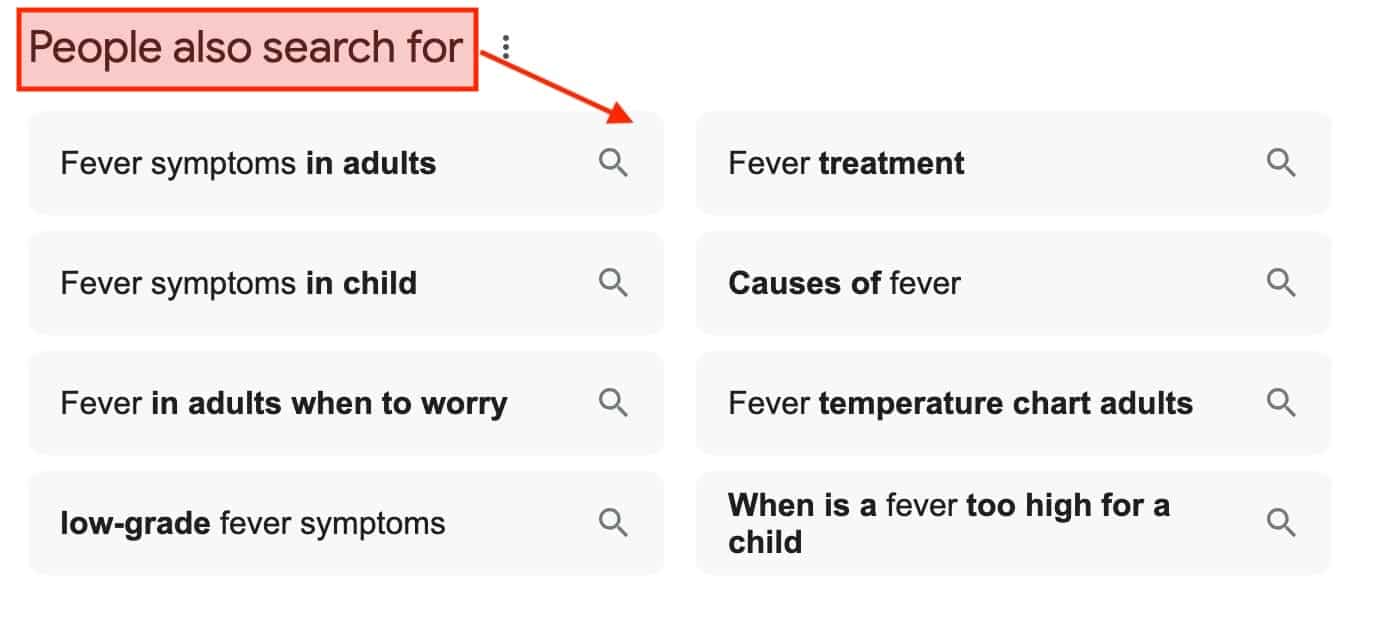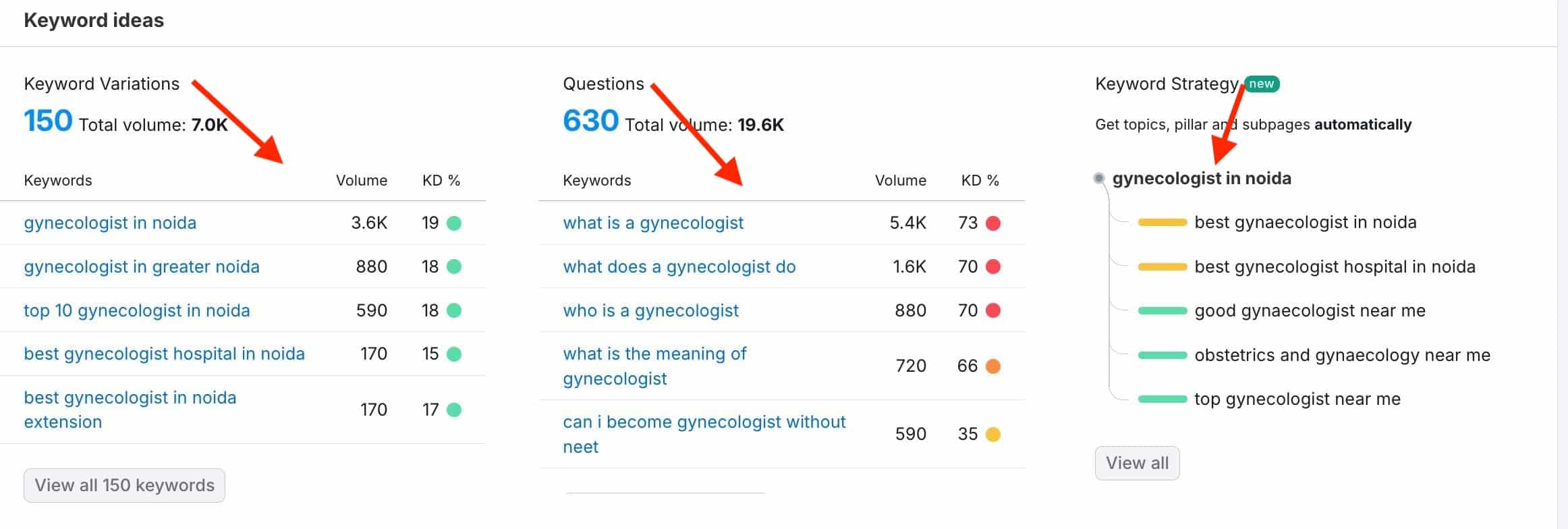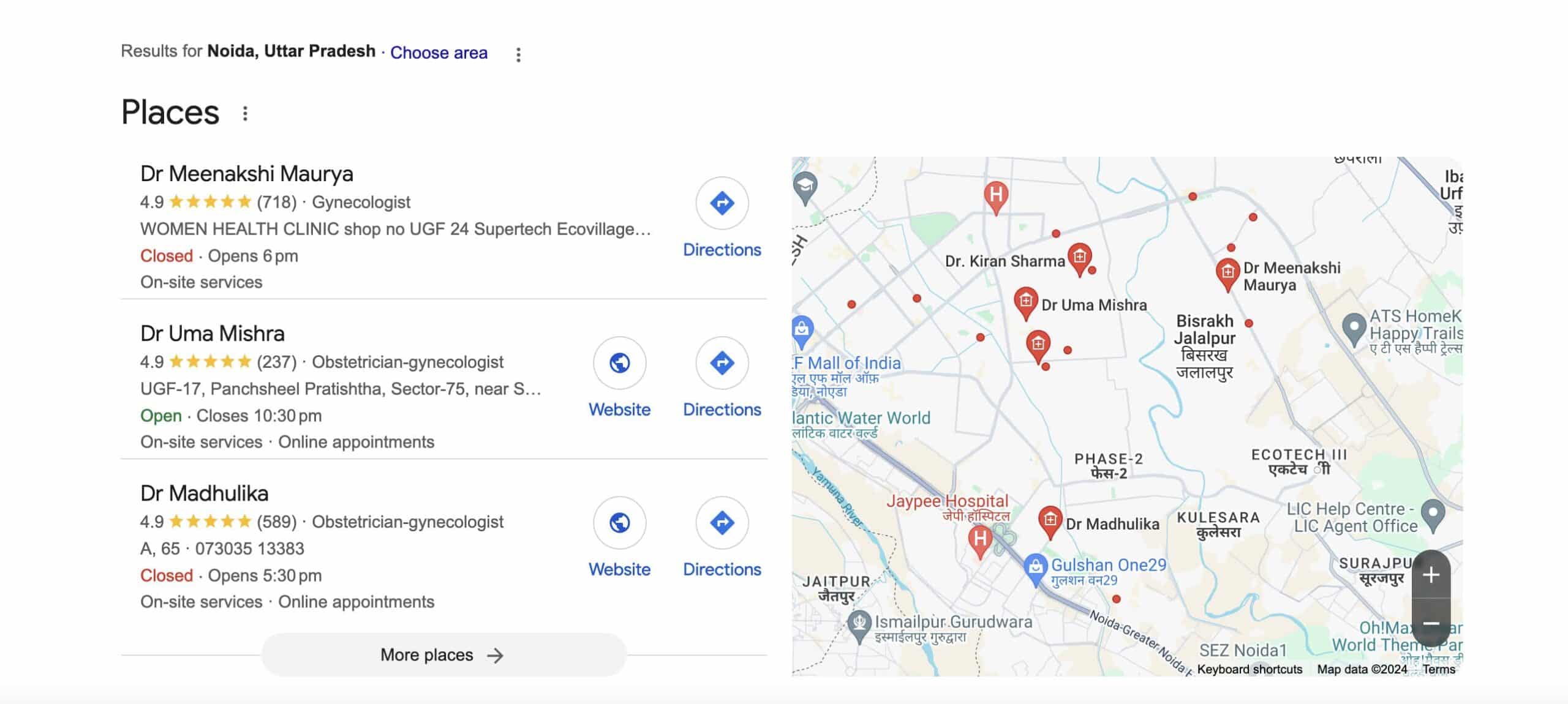
This guide will take you through the basics of SEO for doctors, how it works and practical SEO tips to get more new patients.
What is SEO For Doctor?
SEO for doctor is about optimizing a doctor’s website to show up higher on search engine results pages (SERPs) and get more traffic and more new patients.
It’s about increasing your website’s visibility and getting top positions in search engine rankings, like #1 or #2 on Google. 75% of users never scroll past the first page of search results so top rankings are key to patient acquisition
By implementing SEO strategies your practice will become more visible to patients searching for medical services online and directly impact growth and success, SEO results in 35% increase in appointment bookings in 3 months.

How Does SEO For Doctors Work?
SEO for doctors works by making sure a doctor’s website shows up high on SERPs and involves several strategies specific to the healthcare industry when patients search for medical treatment or services.
Search engines like Google are always crawling the web and evaluating content based on factors like keywords, domain authority and backlinks.
And local medical search engine optimization makes sure your practice shows up in local search results which is crucial for location based queries like “doctor near me”.
Strategies to optimize a medical practice’s online presence include optimizing Google Business listings and utilizing location-specific keywords to enhance visibility in local searches.
Websites with strong local SEO see 50% increase in local search visibility which directly gets more patients.
For example a pediatrician who implemented local SEO strategies showed up in the top 3 Google results for “pediatrician near me” and got 40% more new patient inquiries.

Why SEO is Important for Doctors
SEO is important for doctors because it makes sure their website shows up top of relevant search results on search engines like Google, Bing. So patients can find and choose their services.
Unlike paid ads SEO allows medical practices to get new patients organically and get long term benefits without ongoing ad costs.
A strong online presence also builds credibility and trust as patients view top ranking sites as more trustworthy.
And local SEO is key to targeting patients in specific geographic areas so your practice shows up to those searching for medical services near them.
By increasing your online visibility SEO will make your practice stand out in the competitive healthcare industry and get more patient inquiries and appointments.
Unlock Your Online Potential Today
Perfectly simple & easy to distinguish free hour when power of choice isnothing prevents our being. Mistaken idea denouncing
What do Patients Search for Online?

When optimizing SEO for doctors it’s important to think about what patients search for online. Patients search for health related information, specific medical services or nearby healthcare providers.
For example common searches are “symptoms of diabetes” or “best cardiologist near me”. These searches vary depending on your medical specialty—primary care searches will be different from those related to pediatric care. Understanding what’s behind these searches is key.
Patients may be looking for general information or ready to take action like booking an appointment. “Near me” searches are particularly important as most patients need face to face consultations.
By targeting keywords across all search intents—informational, navigational and transactional your practice can reach patients at every stage of their journey. This will not only improve search engine rankings but also patient engagement and appointments.

SEO Tips for Doctors Website
These SEO tips will walk you through the process of getting your website seen and ranked higher in search results. Let’s get into each one.
Keyword Research for Doctors

Keyword research is the foundation of any doctor SEO. By knowing what patients are searching for and matching your website content to those searches you can get more visible and get more patients.
Step 1: Patient Intent
The first step in keyword research is understanding patient intent, which is the driving force behind effective SEO. Patient intent can be categorized into three levels:
- High Intent Searches: These are patients ready to book an appointment. Examples include practice or doctor name searches like “Dr. Smith orthopedic surgeon” or “near me” searches like “pediatrician near me”. These searches indicate patients are in the final stages of their decision making process and are close to choosing a healthcare provider.
- Medium Intent Searches: These patients have done some research and are further along in the process but might not be ready to book an appointment yet. Examples include treatment searches like “physical therapy for back pain” or condition searches like “arthritis treatment”. These patients are looking for solutions and might need more information before making a decision.
- Low Intent Searches: These are symptom searches where patients are in the early stages of their healthcare journey. Searches like “knee pain” or “migraine symptoms” fall into this category. While these searches might not convert immediately they are still important for building brand awareness and trust.
Step 2: Create a Target Keyword List
Once you understand patient intent the next step is to create a targeted keyword list specific to your medical practice. Start with a “seed” list that includes your brand name, the treatments you offer and the conditions you treat. Using a keyword research tool like SEMrush or Ahrefs you can expand this list and find related keywords.
When building your keyword list, focus on the following factors:
- Traffic: Identify keywords with significant monthly search volume. These should have enough traffic to be worth targeting.
- Difficulty: Evaluate the competition for each keyword. Tools like Ahrefs have a difficulty score which shows how hard it will be to rank in the top 10 for that keyword. You want to find high intent keywords with good traffic and manageable difficulty.
Related Keywords
Your keyword research should also give you related keywords to supplement your targeting.
For example if you’re targeting the term “leg pain” you might also consider related searches like “leg pain treatment”, “causes” and “recovery”.
Including keyword research in your SEO strategy is key for doctors who want to target local and long tail keywords. This will get you more patients and keep your practice competitive in a crowded healthcare space.
Unlock Your Online Potential Today
Perfectly simple & easy to distinguish free hour when power of choice isnothing prevents our being. Mistaken idea denouncing
Local SEO for Doctors

Local searches are crucial in enhancing a doctor’s online visibility to attract patients in their geographical area. Local SEO is key for doctors who want to get patients in their area. Most patients are looking for healthcare providers near them so optimizing your online presence for local search is vital to grow your practice.
Step 1: Optimize Your Google Business Profile
First start by setting up and optimizing your Google Business Profile. This is one of the most important elements of local SEO as it will get your practice to show up in local search results especially in the local pack on Google.
Make sure your profile is complete with all the information including your practice name, address, phone number (NAP) and business hours. Adding photos of your office and services will also make your profile more appealing.
Studies show businesses with complete profiles are 2.7 times more likely to be considered reputable (Google My Business).
Step 2: Target Local Keywords
Next identify and target local keywords relevant to your medical practice. This includes phrases like “dentist near me” or “pediatrician in Delhi”. Tools like Google Keyword Planner, Ahref, Semrush tools can help you find local search terms with good traffic and manageable competition.
Include these keywords in your website content, meta tags and Google Business Profile to get more visibility in local search.
Step 3: NAP Consistency
Consistency is key in local SEO. Your practice’s name, address and phone number (NAP) should be same across all online platforms including your website, Google Business Profile and online directories like Just Dial or Shulekha.
Inconsistent information will confuse search engines and potential patients and reduce your chances of ranking in local search results.
Step 4: Manage Online Reviews
Patient reviews are a big factor in local search rankings and patient trust. Encourage happy patients to leave reviews on your Google Business Profile and other relevant platforms.
Respond to reviews, positive and negative, to show that you value patient feedback and are committed to improving your services.
A bunch of positive reviews will not only boost your local search rankings but also your practice’s credibility.
Step 5: Build Local Citations
Citations are online mentions of your practice’s name, address and phone number on websites other than your own. Building citations on local directories, medical listing sites and even local news outlets will strengthen your local SEO.
The more consistent and widespread your citations the more search engines will consider your practice as a legitimate and trustworthy local business.
Step 6: Geo-Targeted Content
Create content that’s specific to your local audience to supercharge your local SEO. This could be blog posts about common health issues in your area or landing pages for services you offer in specific locations. By using location based keywords in your content you can.

On-Page SEO Optimization for Doctor Websites
On-page SEO is crucial to make your doctor’s website rank well and attract patients.
Optimize each page of your website and make it easy for patients to find your medical practice. Here’s how you can optimize your medical website in 5 easy steps:
Step 1: Meta Titles and Descriptions
First step in on-page SEO is to craft meta titles and meta descriptions for each page of your website. Meta titles should have relevant keywords like “pediatric care in Delhi” or “top cardiologist in Noida”. Descriptions should summarize the page content and have a call to action like “Book your appointment today.”
These are important because they decide whether a user will click on your site. A well crafted title and description will improve your click through rate and bring more website traffic and new patients.
Step 2: Header Tags for Structure and Readability
Using header tags (H1, H2, H3 etc.) is important for both SEO and user experience. Your H1 tag should clearly state the main topic of the page like “Comprehensive Pediatric Care”. Subheadings (H2, H3) should break down the content into smaller sections and make it readable and help search engines understand the hierarchy and relevance of your website content.
Using header tags will improve your search engine rankings and patients will find what they are looking for quickly.
Step 3: Alt Text for Images
Adding alt text to images is another on-page SEO aspect. Alt text describes the image content which helps search engines understand its relevance to the page. For example if you have an image of a patient receiving treatment, the alt text could be “patient undergoing physical therapy”.
This will not only get you into image search results but also make your site more accessible to visually impaired users. By including relevant keywords in your alt text you will boost your doctor SEO and improve your search engine rankings.
Step 4: Internal Links and URL Structure
A well structured internal linking is important to guide patients through your website and to find relevant medical services. Internal links connect different pages of your site like linking a blog post about “diabetes management” to a service page on “diabetes treatment”. This will keep users engaged and enhance their experience.
Also ensure your URLs are clean and descriptive and include relevant keywords related to the page content. For example use URLs like “www.yourpractice.com/diabetes-treatment” instead of generic ones. This structure will improve your search engine rankings and make your site easy to navigate for patients.
Step 5: Page Speed and Mobile Responsiveness
Fast loading pages and mobile friendly design is important for both user experience and SEO. Search engines like Google consider page speed and mobile responsiveness as ranking factors.
To improve your site’s speed optimize images, use browser caching and minimize code. Make sure your website is fully responsive meaning it should work on all devices including mobile devices.
A site that loads fast and is easy to navigate on mobile will rank higher in SERPs and keep visitors on the page longer and hence higher conversion rates and more patients.
Create High-Quality Content

Creating quality content is important for doctor SEO and to get your medical practice online. Google’s guidelines stress on creating helpful content that is valuable, relevant and targeted to your audience.
Step 1: Follow Google’s Guidelines for Helpful Content
Google says create content that is designed for users not for search engines. This means your content should focus on providing accurate, relevant and up-to-date information that meets the needs of your patients.
For doctors this could be blog posts that address patient concerns, FAQs about specific treatments or detailed guides on managing chronic conditions.
To make sure your content meets Google’s SEO standards avoid creating content just for the sake of ranking. Instead create content that genuinely helps your audience.
Google values content written by experts or enthusiasts who have in-depth knowledge of the topic, in healthcare field that means content written or reviewed by qualified healthcare professionals.
Step 2: Detailed Content
Quality content should be detailed and cover the topic thoroughly. This will not only help your content to rank higher in SERPs but also be useful to patients.
For example if you’re writing a guide on “hypertension management” make sure it has sections on symptoms, treatment options, lifestyle changes and when to see a doctor.
The more detailed your content the more it will meet the needs of your patients and rank well in google search results.
Apart from being detailed your content should also be easy to read. Avoid medical jargon and use simple language that patients can understand.
This will make your content more shareable and linkable by other good sites and thus boost your search engine rankings.

Technical SEO for Doctor Websites
Technical SEO is the foundation of your SEO strategy for doctor websites so search engines can crawl, index and rank your content.
For medical practices, technical optimization of your website is key to improving your search engine rankings and getting more patients.
Step 1: Fast Page Load Time
Page speed is a user experience and search engine optimization factor. Slow pages lead to high bounce rates which hurts your search engine rankings. Optimize your website by compressing images, enabling browser caching and minimizing JavaScript and CSS files.
Step 2: Mobile Responsiveness
Most patients are online searching on mobile devices so having a mobile friendly website is a must. Make sure your site is fully responsive and seamless across all devices. Google prioritizes mobile friendly sites in its rankings so this is a crucial part of your medical SEO.
Step 3: Use HTTPS Protocol
Security is top priority for both patients and search engines. Make sure your website uses HTTPS which not only protects patient data but also increases your site’s trust and search engine ranking.
Step 4: XML Sitemaps and Robots.txt
XML sitemap helps search engines crawl and index your site efficiently and robots.txt file tells search engines which pages to index. Updating these regularly ensures your medical website is fully optimized for search engines.
Step 5: Schema Markup
Schema Markup is a technical SEO tool that makes your site visible in search engines pages by providing search engines with more information about your content.
For doctors, using schema types like “Physician,” “MedicalClinic”, “Gynecologic”, “Dentist”, “Dermatology” and more can help your practice stand out. Schema markup can also increase your chances of showing up in rich snippets which can drive more clicks and get more patients to your site.

Link Building and Off-Page SEO for Doctors
Digital marketing services are essential for businesses because they allow companies to reach and engage with their target audience through various online channels. IMMWIT provide a range of digital marketing solutions such as search engine optimization (SEO) services, social media marketing, email marketing, and pay-per-click advertising, social media marketing. By utilizing these services, businesses can increase their visibility online, drive more traffic to their website, and ultimately convert more leads into customers.
Step 1: Build Quality Backlinks
Quality backlinks from other reputable websites tells search engines that your medical website is a trusted source of information.
To build these backlinks, consider guest blogging on other healthcare websites, interviews or collaborating with other healthcare professionals.
Also getting listed in other reputable online directories and medical listings can add to your backlink profile.
The more quality backlinks you have the higher you’ll rank in search engine results pages (SERPs).
Step 2: Partner with Local Businesses
Local partnerships can be a source of backlinks and can boost your local SEO. Consider partnering with local businesses, health clinics or community organizations.
For example you can partner with a local gym or wellness center to co-host health events and in return they can link to your website.
These local listings and partnerships not only improve your search rankings but also increases your presence in the local community.
Step 3: Use Social Media Platforms
Being on social media is a must for a doctor’s online presence. Platforms like Facebook, LinkedIn and Instagram allows you to connect with patients, share health tips and promote your clinic or hospital.
Post informative content regularly like blog posts, patient testimonials or health updates to increase your visibility and engagement with potential patients.
Step 4: Engage with Patients on Social Media
Engagement is the key to building a loyal online following. Respond to comments, answer questions and interact with patients who reach out to you on social media.
This engagement not only builds patient trust but also gets more people to visit your website and ultimately drive more traffic and improve your search engine rankings.
Step 5: Monitor and Measure Social Media Impact
To make sure your social media efforts are part of your overall SEO strategy, you need to monitor your social media metrics. Use Google Analytics and social media insights to track engagement, referral traffic and performance of your posts.
This will help you refine your strategy, focus on what works and build your online presence stronger.
How to Measure SEO Success for Doctors

Measuring SEO for doctors means tracking the key metrics that matters to your seo strategy.
Start by monitoring your search engine rankings for medical keywords using Google Search Console. If your rankings improve, it means your seo efforts are driving more visibility.
Next, analyze organic traffic through Google Analytics to see if more potential patients are visiting your site. Track patient inquiries and conversions like appointments booked to measure real results.
Track engagement metrics like bounce rate and time on site to see if visitors find your website content valuable. Finally monitor online reviews on Google My Business; positive reviews boost your local SEO and attract new patients.
These metrics will give you a complete view of your SEO success and help you refine your strategy and improve your medical practice’s online presence.
How to Rank Higher on Google for Doctors
Getting to the top of Google is crucial for doctors who want to attract more patients online. By optimizing your website and implementing these SEO strategies you can boost your visibility.
Quick Tips
- Do keyword research.
- Optimize for mobile and page speed.
- Claim and optimize your Google Business Profile.
- Create patient centric content.
- Get high quality backlinks and manage online reviews.
- Ensure NAP (Name, Address, Phone) is consistent across directories.
- Use schema markup to increase search engine visibility.
- Update your content regularly to keep it fresh.
- Focus on local SEO to target local patients.
- Engage with patients on social media to build trust and drive traffic.
See How We Can Drive More Traffic to Your Website
When you partner with IMMWIT, you can expect a comprehensive and customized approach to your business SEO campaigns.
Frequently Asked Questions
What is local SEO for doctors?
Local SEO for doctors means optimizing a medical practice’s online presence to show up in local search results. This includes strategies like optimizing your Google Business Profile, ensuring consistent NAP (Name, Address, Phone) across directories and using location based keywords to attract patients searching for medical treatment or services in your area.
How is SEO used in healthcare?
SEO in healthcare is used to increase the online visibility of medical practices by optimizing their website to rank higher in SERPs. This includes using relevant keywords, creating quality content, optimizing technical aspects of the website and earning backlinks to attract more patients and build trust in the practice.
How much does medical SEO cost?
Cost of medical SEO varies depending on the scope of SEO services and the expertise of the SEO agency. It can range from $200 to $2,000 per month for ongoing SEO services and some practices opt for one-time projects that can be more expensive. Invest in quality SEO to see long term results.
What is SEO in healthcare?
SEO in healthcare means Search Engine Optimization. It means optimizing a medical provider’s online presence, website and content to rank higher in SERPs.
Latest Blogs


Local SEO for Auto Repair Shops: The Complete 2025 Ranking Guide







